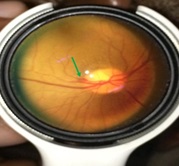Smartphone-Assisted Glaucoma Screening in Patients With Type 2 Diabetes: a Pilot Study
Medical hypothesis discovery and innovation in ophthalmology,
Vol. 9 No. 1 (2020),
19 November 2019
,
Page 61-65
Abstract
We aimed to determine true and false positives of glaucoma screening, relying solely on photos of the retina, taken with a smartphone. We performed a descriptive and analytical study on patients with type 2 diabetes at the National Obesity Centre, Yaounde, Cameroon. Participating patients had retinal photography sessions using an iPhone 5s (iOS 10.3.3; Apple, Cupertino, CA) coupled to the Make in India Retinal Camera (MIIRetCam; MIIRetCam Inc., Coimbatore, TN, India). Obtained pictures of the retina were stored and transferred via the internet to an ophthalmologist to assess glaucoma. Selected patients were then invited to undergo a conventional ophthalmological examination to confirm the diagnosis. A total of 395 patients were screened, 39 (including 20 women) were diagnosed with suspicion of glaucoma based on retinal photos, a prevalence rate of 9.87%. The following signs were found; C/D equal or more than 0.5 in 64.1% (25/39), asymmetric C/D >0.2 in 35.9% (14/39), papillary haemorrhage in 10.2% (4/39) and retinal nerve fibre deficiency in 2.5% (1/39). Only 14 of 39 patients with suspicion of glaucoma were examined, giving a lost-to-follow-up rate of 64.1%. Chronic open-angle glaucoma was confirmed in 8 patients (true positives) and absent in 6 patients (false positives). The prevalence of smartphone-detected glaucoma and lost-to-follow-up rates were high. So we need to improve this type of screening, with additional tests like transpalpebral applanation tonometer and the smartphone Frequency Doubling Technique visual field combined with better education of patients to increase their adherence to follow-up.
References
Pascolini D, Mariotti SP. Global estimates of visual impairment: 2010. Br J Ophthalmol. 2012;96(5):614-8. doi: 10.1136/bjophthalmol-2011-300539 pmid: 22133988
Quigley HA. Glaucoma. Lancet. 2011;377(9774):1367-77. doi: 10.1016/S0140-6736(10)61423-7 pmid: 21453963
Jonas JB, Aung T, Bourne RR, Bron AM, Ritch R, Panda-Jonas S. Glaucoma. Lancet. 2017;390(10108):2183-93. doi: 10. 1016/S0140-6736(17)31469-1 pmid: 28577860
McManus JR, Netland PA. Screening for glaucoma: rationale and strategies. Curr Opin Ophthalmol. 2013;24(2):144-9. doi: 10.1097/ICU.0b013e32835cf078 pmid: 23287103
Zhang S, Sun J, Liu S, Liang Y, Hu Y, Congdon N, et al. Integrating opportunistic glaucoma screening into general health examinations in China: A pilot study. Clin Exp Ophthalmol. 2019. doi: 10.1111/ceo.13564 pmid: 31152490
McMonnies CW. Glaucoma history and risk factors. J Optom. 2017;10(2):71-8. doi: 10.1016/j.optom.2016.02.003 pmid: 27025415
Iester M, Mermoud A, Schnyder C. Frequency doubling technique in patients with ocular hypertension and glaucoma: correlation with octopus perimeter indices. Ophthalmology. 2000;107(2):288-94. doi: 10.1016/s0161-6420(99)00058-5 pmid: 10690827
Russo A, Mapham W, Turano R, Costagliola C, Morescalchi F, Scaroni N, et al. Comparison of Smartphone Ophthalmoscopy With Slit-Lamp Biomicroscopy for Grading Vertical Cup-to-Disc Ratio. J Glaucoma. 2016;25(9):e777-81. doi: 10.1097/IJG.0000000000000499 pmid: 27513903
Bilong Y, Katte JC, Koki G, Kagmeni G, Obama OPN, Fofe HRN, et al. Validation of Smartphone-Based Retinal Photography for Diabetic Retinopathy Screening. Ophthalmic Surg Lasers Imaging Retina. 2019;50(5):S18-S22. doi: 10.3928/23258160 -20190108-05 pmid: 31100178
Sharma A, Goyal A, Bilong Y, Shah P, Banker A, Kumar N, et al. Comparison of a Smartphone-Based Photography Method with Indirect Ophthalmoscopic Assessment in Referable Retinopathy of Prematurity: A Smart Retinopathy of Prematurity Model Pilot Study. Ophthalmol Retina. 2019; 3(10):911-2. doi: 10.1016/j.oret.2019.06.006 pmid: 31422107
Kumar N, Francesco B, Sharma A. Smartphone-based Gonio-Imaging: A Novel Addition to Glaucoma Screening Tools. J Glaucoma. 2019;28(9):e149-e50. doi: 10.1097/IJG.0000000 000001306 pmid: 31211742
Alawa KA, Nolan RP, Han E, Arboleda A, Durkee H, Sayed MS, et al. Low-cost, smartphone-based frequency doubling technology visual field testing using a head-mounted display. Br J Ophthalmol. 2019. doi: 10.1136/bjophthalmol-2019-314031 pmid: 31530566
Mariakakis A, Wang E, Patel S, Wen JC. A smartphone-based system for assessing intraocular pressure. Conf Proc IEEE Eng Med Biol Soc. 2016;2016:4353-6. doi: 10.1109/EMBC.2016. 7591691 pmid: 28269242
Sanchez Gonzalez S, Calvo Lozano J, Sanchez Gonzalez J, Pedregal Gonzalez M, Cornejo Castillo M, Molina Fernandez E, et al. [Assessment of the use of retinography as a screening method for the early diagnosis of chronic glaucoma in Primary Care: Validation for screening in populations with open-angle glaucoma risk factors]. Aten Primaria. 2017;49(7):399-406. doi: 10.1016/j.aprim.2016.10. 008 pmid: 28126193
Li Y, Shi J, Duan X, Fan F. Transpalpebral measurement of intraocular pressure using the Diaton tonometer versus standard Goldmann applanation tonometry. Graefes Arch Clin Exp Ophthalmol. 2010;248(12):1765-70. doi: 10.1007/ s00417-009-1243-y pmid: 20495818
Hoffelt Z, Fallon S, Wong BA, Lucas B, Coleman AL, Mills RP, et al. Glaucoma public service announcements: factors associated with follow-up of participants with risk factors for glaucoma. Ophthalmology. 2011;118(7):1327-33. doi: 10. 1016/j.ophtha.2010.12.013 pmid: 21439644
- Abstract Viewed: 1041 times
- Free Full Text PDF Downloaded: 500 times


